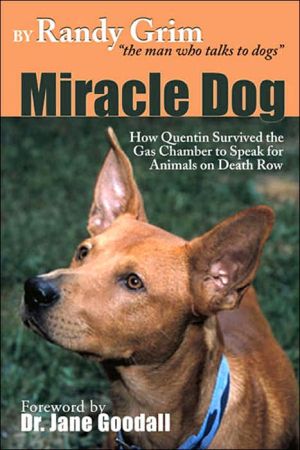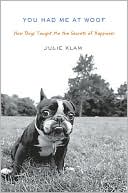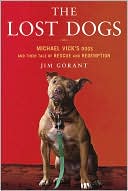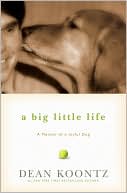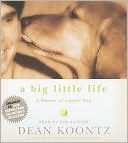Miracle Dog: How Quentin Survived the Gas Chamber to Speak for Animals on Death Row
The day Randy Grim got a phone call from a St. Louis animal shelter worker pleading with him to take yet another unwanted dog to his no-kill shelter, he had no idea that the dog would change his entire life. The dog had survived a horrifying procedure still practiced in some animal shelters: "euthanasia" by carbon monoxide gas poisoning. The account of Quentin's ordeal and the crusades Grim and Quentin have undertaken on behalf of abandoned animals is sobering, hilarious, and ultimately...
Search in google:
The day Randy Grim got a phone call from a St. Louis animal shelter worker pleading with him to take yet another unwanted dog to his no-kill shelter, he had no idea that the dog would change his entire life. The dog had survived a horrifying procedure still practiced in some animal shelters: "euthanasia" by carbon monoxide gas poisoning. The account of Quentin's ordeal and the crusades Grim and Quentin have undertaken on behalf of abandoned animals is sobering, hilarious, and ultimately uplifting. Grim and Quentin have appeared on numerous television shows including Today Show, Animal Planet, It's a Miracle, CNN, MSNBC, CBS News, CBS Early Show, Access Hollywood and in People Magazine, National Geographic, Forbes and Guideposts. Midwest Book Review Written by the founder and president of Stray Rescue in St. Louis, Missouri, who won the first Guardian Award for his work to save homeless and maltreated animals, Miracle Dog is the true story of a dog who survived a shelter gas chamber to become the author's beloved companion, personal inspiration, and the "poster child" for a no-kill animal shelter movement. Narrated candidly, offering a glimpse behind the scenes to the cruelties mankind inflicts on his so-called "best friend," Miracle Dog is a profoundly heart-touching story with a resonating moral not only for animal lovers, but also humans who understand that how we treat animals influences how we treat each other. Black-and-white photographs, a list of resources and no-kill shelter locations, and a foreword by renowned wildlife scientist and conservationist Jane Goodall round out this ultimately positive testimony.
No Place Like Home\ My bedroom is finally going to see some action. But it’s not what you’re thinking. A photographer is on his way over-again, no, it’s not what you are thinking. He is shooting pictures on my bed for a national calendar, and NO, it’s not what you are thinking. The subject is going to be my famous kid, Quentin, the Basenji mix, the dog of miracles.\ My bedroom is a cross between Out of Africa and Scooby Doo. A mosquito net hangs over the bed and pictures of monkeys cover the walls. The furniture is all Tahitian: lots of bamboo. And I have five dogs, to boot; sagebrush has nothing on hairballs the size of basketballs. In a panic, I grab a fistful of Swiffer dusters and begin frantically chasing the tumbleweeds back and forth across the floor. I make up a fresh bed with its crowning glory-a handmade African quilt covered with elephants-that I think will bring out the beauty of Quentin’s eyes, as brown and large as a deer’s.\ Fox 2 News reporter Paul Schankman has been following Quentin and me around for months, and Paul will be at the calendar shoot as well, filming it for Fox. My life has changed dramatically over the last few months. I now have two jobs. One is running the organization I founded, Stray Rescue of St. Louis. Stray Rescue’s sole purpose is to rescue stray animals in need of medical attention, restore them to health, and place them in loving adoptive homes.\ My other, newer job is being the spokesperson, manager, and factotum for Quentin. As far as I know, I am the only person on the planet who is employed by a year-old Basenji mix. Quentin’s claim to fame is miraculous, bizarre, and encouraging. He is the only dog in the country known to have survived a trip to the gas chamber. He lived to tell his tale.\ As I wait for Fox and Starpooch I check my e-mail, and the more glamorous and bizarre aspect of my job as Quentin’s public-relations man fades. I’m hit by the reality of what my life was like before Quentin came. In my inbox are a handful of messages about a dog who’s loose on the streets at this very moment. Now that I’m "the man who talks to dogs"-the title of the book that was written about street dogs and how I try to save them-frantic e-mails and phone calls like these are a daily part of my life.\ My heart sinks. The stray looks close to death, but no one can get close enough to help him. Here’s a surprise: he doesn’t trust humans. There are degrees of "wildness" in street dogs. Some were dumped on the streets at early ages, while others were actually born in the urban wild. Those that were discarded early on may seem to be wild, but actually do have memories of human contact, and the trick is to jar those memories of trust even if they have been skewed by abuse and neglect.\ Damn! He’s been sighted. I have to go help him, even if it makes me late for Quent’s glamour shoot. Off I go at unprecedented speed, a full forty miles per hour-I won’t go any faster without a gun to the head.\ My car knows the mean streets of St. Louis by heart. On the corner of Lafayette and Nebraska lies a shepherd mix in a tight ball, maybe dead. I can’t see breathing. I grab a pocketful of dog treats, climb out of my car, and slowly, gingerly, approach the lifeless mutt.\ "Hey boy, I’m here to help you. Are you alive?"\ He lifts his head and stares me down. I can almost see the wheels turning in his head, forming a plan of escape. Injured and now officially pissed off that I am even there, he growls and then lashes out to bite me. I hear his jaws snap. But I don’t leave; instead I squat down to his level, avoiding eye contact. Taking advantage of the fact that I am staying put, he rockets up and starts to run. The poor guy is running on three legs; his one usable back leg has an open wound the size of a dinner plate, exposing muscles, tendons and bone. Good God. I gasp in disbelief and reach for my cell phone.\ Animal Regulation and Stray Rescue have formed a working relationship over the years. Stray Rescue pulls dogs from death row and in return I usually get a high-speed response when I call in for assistance. I don’t have my tools of the rescue trade with me and I need a net. "Please get here," I tell Rosemary Ficken, the supervisor at St. Louis Animal Regulation Center. "Quick." I stay on the dog’s case at a safe distance.\ Minutes pass. Containing the terrified dog is not easy. Like a scene from Hansel and Gretel, I leave a trail of treats to keep him near the hill where he was first spotted. It is working; he follows the trail back to the starting point. I hear diesel thunder. It’s the Animal Control truck on the horizon. You can hear that truck miles away.\ When they pull up there’s no time for formalities. "I’ve kept him in this area with morsels of food, but we need the net."\ "No problem, Randy." The two women go back to the truck for the net.\ He’s going to bolt, I keep thinking. His mangled body can’t possibly take the strain, but he’ll try to get away.\ Against all odds, he doesn’t. Before he knows it, the Animal Control workers perform their magic. "One, two, three," and the monster spider web drapes the frightened and angered shepherd.\ But he thrashes like a live fish on the hot pavement and I know I have to start calming him down. Watching him biting through the netting, I have no choice but to try to stroke a part of his battered frame that isn’t wounded or in pain, all the while keeping my fingers intact. I reach between his ears, stroking softly, again and again. Somehow you can transmit to dogs, by touch and by voice, that you won’t hurt them, that you love them. They get it. All of them, however much they are in pain, get it. I start to talk him down.\ "Hey, hey, it’s okay. Your bad days are over. Just let me try to help you." I continue the stroking and whispering, repeating this mantra. As if hypnotized, he begins to relax and the growls-half pain, half panic-slowly diminish and then disappear entirely.\ But the handlers are rough. Politely, I ask if I can take the pole so it will function more like a collar and leash than a choke hold. As I place it around his bloody neck, I keep the calming mantra going. He is shivering, quaking with terror. Up close, I can see that he is so beaten up that I don’t know how he survived. The mantra is working. He nestles close to me as the net is pulled away, as though he has known me for a long time. I now start to walk him, trying to jar pleasant memories of all dogs’ favorite pastime: walkies.\ I pick him up and lay his broken body across the back seat of my Aztec. He contentedly curls up, happy to be safe and surrounded by kindness for the first time in a long time-or maybe, from the looks of it, for the first time ever. Through tears I name him "Titan" and whisk him off to the Vet Clinic. And then back to my other job as Quentin’s overseer, though I knew Quent would understand helping out a fellow canine in need. Titan is a street dog, Quentin a turn-in. Both were unwanted.\ Even if a street dog doesn’t die of gunshot wounds or from being used as bait in dog fighting or from being thrown off a bridge, once he winds up in the shelter his chances for survival are the same as a turn-in’s. If not adopted within five working days, there’s a 100 percent chance that, even with so much love to give, they will both wind up in the gas chamber.\ The doorbell rings, the world’s most annoying rendition of the Twelve Days of Christmas that eerily resists all efforts at reprogramming. The dogs go into their howling routine, off-key. Starpooch Company calendar photographer Randy Solomon is at the door.\ Starpooch is donating proceeds from the calendar sales to shelters across America, my main reason for accepting this gig on Quentin’s behalf. The calendar will\ \ * * *\ [Later.] I find myself launching into Quentin’s story, telling my guests about how he came to me, telling them about how he almost died, telling them about how he lived to steal my lattes and fart on my steps. But what I probably should have said was, "Look in his eyes. They’ll tell you everything you need to know."\ As you turn onto Gasconade Street, you can hear the eerie wails of dogs and the echo of true fear. At first glance the drab concrete walls and the high fencing give the appearance of a miniature San Quentin prison, but the prisoners here don’t wear stripes. The sixty-two-year-old animal penitentiary is an oversized death row; its inmates have little hope for a reprieve. This is the Gasconade, the St. Louis Animal Regulation Center, the local pound for homeless and unwanted pets.\ The Gasconade is a squat, ugly rectangular box with the look of a police station or a government building. Inside, the small relic of a lobby area oozes with the stench of wet dog and feces. Purebred dog charts and missing-animal posters cover the walls. Behind a glass casing sit the wardens, who have the power to buzz you into the endless halls of dogs and cats waiting, at first cluelessly and later with knowledge and trepidation, for their execution. As you approach the door to the cells, the howls grow louder and fear becomes real. The buzzer sounds and you may enter.\ Cain’s day came on August 5, 2003. His "owners," a husband and wife, are turning him in to the shelter. It’s hard to imagine that they would move into an apartment remembering their VCR but overlooking the family dog. But it’s true; the VCR is moving with the family, and Cain is brought here.\ As he is led into the Gasconade, he is on high alert at the howls and moans of fear and misery and the smell of filth, fear, and something else. Something sinister and unfamiliar. He will later come to recognize it as the smell of death. His gentle, deer-like features take on the look worn by all the pound’s other inmates: his eyes fill with terror and he tucks his tail beneath him. The sights and sounds of the world he once called home are gone. No more sunlight, no more fresh air.\ As his papers are filled out and processed at the window, the buzzer sounds and Cain’s once-outstretched ears flop down like a hound’s. A towering human enters the minute lobby. The worker places a slip lead on Cain’s neck. The dog doesn’t know this, but if he resists, he will be put in a pole noose and dragged to his cell. However, Cain submits. Confusion, fear, and panic saturate every fiber of his skeletal frame as he is led away from his family.\ Cain’s cell is 5A. This row of cells faces the St. Louis Animal Regulation Center’s gas chamber.\ Cain’s pen holds up to five dogs. He is the fifth. The other four dogs pass the time by pacing and staring at anyone who may walk by, hoping they will be the people to take them away from this hell. Cain curls into a tight ball-in his mind, a ball of protection-as he lies on the recently hosed-down concrete floor.\ As the wardens pass by, he eyes them, but nobody stops to take him out. Cain’s psyche tells him to stay put. It will get better. But the sounds of wailing dogs tell him something different. He can see it from his pen. His eyes fixate on that chamber of horror.\ In time it becomes apparent to him that he is now a witness. A blue train loaded with fellow inmates rattles up to the metallic box, and the dogs are herded inside the chamber. As they enter, some of them are wagging their tails. But only lifeless bodies come out. This is a ritual that becomes embedded into his mind as he witnesses it over and over again during the next three days.\ Why?\ Cain lays his head down and ponders his future as the other four-legged inmates pace the cell. He’s too nervous and scared to think of being hungry, which is one small blessing. Food, which was a luxury in his previous life, is a rarity here. Low-level growls become normal, as unheard as a constant humming, while his cellmates scurry the pen in search of food morsels. A worker comes by with a hose and sprays them all down. Cain now is cold and wet. Sleeping is not an option.\ Come morning, Cain stretches and for a brief second he forgets where he is. He is terrifyingly dragged back into his new reality as a train of crates, filled with barking dogs, is lined up in front of the chamber. Cain retreats into his protective fetal position and closes his brown eyes, not to slumber but to escape the moment. He raises his head from the floor, which is now covered in urine and feces, and sneezes.\ Barking permeates the prison as new arrivals are marched into cells marked 5B. 7A’s inmates, who were on the death train, are now herded into the gas chamber via the trolley. A fight breaks out among the newbies and the wardens scramble to break it up and separate the dogs with cold water from a nearby hose. A defeated dog lies down, blood trickling from his muzzle.\ Cain looks upon the fallen soldier with empathy. His fetal position no longer comforting, Cain fearfully joins the pack and paces. He sneezes again and mucus falls to the concrete floor. 5B’s pack is sick, and the newest phlegm-sounding cough has spread throughout the nearby cells. Cain wants out.\ \ Official nationwide statistics regarding shelter animals do not exist. The American Society for the Prevention of Cruelty to Animals offers the following numbers:\ * Between eight and twelve million companion animals enter shelters nationwide every year. These are almost evenly divided between "drop-offs," those relinquished by "owners," and "turn-ins," those picked up by animal control. Perhaps nine million-60 percent of dogs and 70 percent of cats-are euthanized.\ * Only 10 percent of the animals in shelters have been spayed or neutered, while 75 percent of pets living in permanent homes are de-sexed.\ * About 60 percent of households in the United States have a pet; the total population of companion animals is about sixty million dogs and seventy-five million cats. The majority of pets are obtained from acquaintances and family members. Only about 10 to 20 percent of cats and dogs are adopted from shelters and rescues, about 15 to 20 percent of dogs are purchased from breeders, and 2 to 10 percent are purchased from pet shops. More than 20 percent of the people who bring a dog to a shelter adopted their animal from a shelter.\ * It is estimated that the number of stray dogs and cats in the United States is now in the tens of millions; some estimates put the number of stray cats alone at seventy million. For every two animals who have permanent homes, there’s one on the street. Many strays are lost pets that were not kept properly indoors or provided with identification, while others are the offspring of unneutered escapees.1\ With the tremendous numbers of animals on America’s streets, animal shelters are a help in returning lost animals. Some provide low-cost spaying and neutering programs. But fewer than 2 percent of cats and only 15 to 20 percent of dogs are returned to their guardians. Most of these were identified with tags, microchips or tattoos.2\ The dark side of America’s shelters is less well known. Government shelters are run for public health reasons, meaning that they don’t have a mandate to find good homes-or any homes-for the animals they take in. They just have to get rid of them.\ No one knows what goes on behind closed doors. Most people don’t want to know. But stories detailing inadequate feeding and watering and rough and neglectful treatment sometime come to light. One such incident occurred in 2001 at the West Gardner, Massachusetts, city animal shelter, which has since been closed. Arthur F. LeBlanc, Gardner’s animal control officer since 1998, was relieved of his duties after a Rottweiler was found dead and half-eaten among two dozen other injured and hungry dogs living in filth. A health agent said conditions were adequate when he had visited the shelter about three weeks earlier, but apparently no cleaning had been done since that visit.\ The situation was obscene. Filth covered the walls, food dishes, and the shelter floor. The only water available for the animals to drink was dripping from a broken heater. All that remained of the Rottweiler was his partially eaten head, spinal column, and paws. He had been cannibalized by his cellmates. Bite marks on other dogs-including at least one puppy-pointed out the likelihood of the same horrific end for them at some time in the future.\ The Gardner Police department filed six counts of cruelty to animals and two counts of willful neglect on February 12, 2001, a week after the appalling conditions were discovered.3\ In December 2003, a reporter for Miami’s WSVN-TV photographed dogs during their final hours in the run at Miami-Dade animal control. The pictures show more than a dozen dogs surrounded by blood and feces. One dog is already dead-he apparently choked on his leash. Another has a leash wrapped around his belly. A puppy sits bolt upright in the midst of the filth and death, staring straight ahead.4\ Broward County Humane Society’s JoAnne Roman commented on the situation. "It’s certainly inhumane for the animals both two- and four-legged. National standard in animal welfare is one animal at a time should be euthanized. Animals are extremely sensitive and perceptive and they understand fear. They can smell it. They can hear it." 5\ These types of stories are all too common in America’s broken government shelter system. Conditions are usually poor, staffing inadequate, and overcrowding the norm. The major culprits are lack of funding and staff. The St. Louis Animal Regulation Center has its share of sad tales and horror stories, but an overcrowded front lobby and rundown conditions are more obvious to the casual visitor.\ Cain paces nervously, glancing often at the injured dog in 7A. He gallops, but doesn’t understand what he is running from-he is pursued by a floating, nameless fear. Coughing and sneezing interrupt his cadence, and he falls to the ground and curls up into a ball, shivering.\ The train clatters up to 5A. Cain slowly lifts his head and cocks it to the left, then to the right, and his ears drop down and back. He knows.\ As the wardens enter the cell, Cain hunkers in the back. The pack becomes a tangled web of panic as the steel pole with its hangman’s noose reaches in. It is time for Cain to fight, to survive, to attack, to do whatever it takes to avoid capture. The first dog is noosed, and Cain watches his fellow cellmate thrash furiously to gain freedom. Eventually the dog succumbs and is pulled from the pack and put into a cage in the train.\ The pole sweeps by Cain’s head and attaches itself around the neck of a terrified dog to his right. Within seconds the dog is gone, never putting up resistance. Cain squirms and moves further into the corner while horror causes his little tan frame to tense up. Trembling, he defecates.\ Cain knows his turn is coming. His eyes dart from one warden to the next and back to the train with its two new unwilling passengers. His only thought is must escape.\ In a panic-driven swiftness, Cain bolts toward the partially opened door. He hits the concrete with a merciless thud and feels the noose tighten around his gaunt neck. Biting at the pole is useless, so Cain jerks back with all his might. His thirty pounds are no match for the heavy-hitting wardens. As he gasps for air, Cain’s paws frantically scratch the cement floor, but continue to slip toward the cage. Earsplitting howls echo through the shelter.\ Must escape.\ Cain’s undersized body slams into the cage’s metal bars, and with one quick movement the noose comes off as the cage door bangs closed. Cain slinks into his fetal position and trembles. He watches as "Tuesday’s" cages empty one by one. He coughs repeatedly and phlegm dangles from his nose.\ Once all the cars are loaded, the train slowly begins to move. His one-way ticket to death now stamped, Cain hoists his head and watches as he passes 5B and then 6A cells, on his way to the gas chamber.\ \ By now my dinner guests are staring at me with open mouths and have abandoned the shrimp platter altogether. I excuse myself and put the tray in the refrigerator. It’s hard for me to tell Quentin’s story, because it grabs me in the gut in a violent sort of way, and I have to take a break before it all gets torn out.\ Quentin isn’t so sentimental. In fact, he’s an outright opportunist. As I sit back down at the dining room table to tell the rest of his story, I watch in amazed horror as he opens the refrigerator door with his mouth and pulls the shrimp tray off the shelf and onto the floor. He’d never done that before. I’d never seen any dog do that before. But then Quentin isn’t just any dog.\ \ Interrupted so RUDELY by flatulence and fallen shrimp, I pull out the port wine and brie cheese and arrange both carefully on the center of the table, away from the reach of unwanted hungry "paws." My guests, as if caught in the middle of a séance, have been rendered speechless as I prepare to end the Quentin saga of survival. Before we sit back down, one by one they all make sure they take advantage of this breather and use it to love on Quentin, regardless of farts. One by one they take turns loving on all my five dogs. They probably just need a dog fix, thinking of their own companion animals and how fortunate they are to have them alive and well.\ Quentin tiptoes to the back of the line of adulation as if making sure the rest of the gang doesn’t think he is "all that." But that is just a ploy to distract so he can sneak back and again open the fridge for another food search. This time, however, I catch him red "paw" handed.\ "Hey, you-stop it now!" I hiss, hoping my friends do not hear Round 2 of the cuisine thief in action.\ Quent glances at me while his jowls start to slowly release the white fridge handle. I’m afraid he may "toot" again after all that tugging, but he keeps his composure. Knowing I am on to him, he hurries back to the front of the doggy affection line with an innocent and blameless look. There are tail wags galore by the entire group as they sop up the attention.\ "It really is a miracle, Randy," says one guest.\ "So how did he do it? Does anyone know?" asks another.\ We settle back around the table and, with our port wine in hand, we toast Quentin and his miraculous deed. I hear slurping sounds coming from the bathroom just feet away, and figure the dogs must be toasting Quent too, with toilet water-their favorite.\ The dogs start to settle in around us at the table and lie down except Quent. He sits dignified next to me, as if he is ready to tell his tale himself. He cocks his head.\ \ The warden reaches into the cell on the cheerless train and injects a snarling Cain with a sedative, acepromazine, which has roughly the effect of one martini. She proceeds to inject the seven other doomed passengers that have been placed with him. One can only imagine what is going through his drowsy mind about what will happen next. Cain feels the sedative rush through his veins, but it only agitates his system and causes him to stand and wobble as if he were drunk.\ Fear consumes Cain. He can’t tuck his tail any farther underneath himself, and he sees no escape from what is about to happen. He didn’t choose to be in this animal hell. He never understood why he was here, what he’d done, or where his family and the yard he used to play in were. He waits his turn.\ Spinning in circles seems to help; at least he is doing something. If he spins intoxicatingly enough, then perhaps he will magically get a reprieve and disappear from this place. Cain’s cellmates seem much calmer; they succumb to the sedative. They either sit and stare depressively or lie down and await their hopeless fates.\ The dogs in 7A and 7B have an unobstructed view of the gas chamber. They watch daily as the mammoth machine massacres whoever goes in, and they watch the lifeless bodies as the trolley pulls them out. These pens even have a view of the truck that transports the motionless carcasses. Staff members wonder what the dogs may be thinking or if they understand what is going on at all. Most of the employees believe the dogs know something is not right and are very much afraid.\ The daunting task of executioner falls onto the shoulders of Rosemary Ficken, a supervisor and fifteen-year veteran of the Gasconade shelter. Ficken tries to spend time with each animal prior to opening the chamber door and sending them inside. Maybe those few soft, kind words will help ease their passage.\ It isn’t Ficken’s fault that the center doesn’t have the funding to rid itself of gassing, or the space to house more animals, or pens without a view of the chamber. It certainly isn’t her fault that people don’t take responsibility for their pets, that they don’t spay or neuter them, that they don’t have the commitment to be their lifetime guardians. She despises this part of her job; she must detach from her inner self to do it. She is consumed by sympathy every time she pulls the switch, but it is, she says, "a necessary evil" of her job.\ Sedated and defeated, the inhabitants of the blue train make their way to the giant, oven-like chamber. The front door window, covered with yellow paper, prevents viewing of the inmates’ final moments. Atop the large oven is an array of switches and lights-green, blue, yellow, and a clear white light that signals when the task is complete and all inside are dead.\ Once the door is closed, it is dark inside, except for a small ray of light that pierces a small, square side window through which the dogs can look helplessly out at the carbon monoxide tank.\ The entire trolley rolls into in the chamber. It fits like a glove. The inmates are secure; the metal door is shut. No last rites are given here. There are no witnesses and no stays of execution. The switch is turned on, and the large green tank pumps its deadly contents into the tiny room.\ Cain watches his fellow inmates slowly succumb to the fatal gas, falling to the metal floor. He fights to survive, and waits for a miracle. No miracle ever has spared the lives of any of the 4,000-plus victims of the past year. In fact, no miracles at all have occurred in the facility’s sixty-two-year history.\ I will not die. I will not fall.\ Cain stares out of the small side window. Five minutes pass, and one by one, his companions perish around him. There is no room to stand except on top of the fallen victims. Cain remains strong. Ten minutes pass. He hears nothing except the sound of his own breathing. Fifteen minutes pass.\ He is still standing as pure oxygen is pumped into the chamber. The alarm sounds, the white light glows, and the door opens.\ \ \ "Oh, my God!"\ Rosemary Ficken’s facial expression says it all. She is either witnessing an act of God or she has completely lost her mind. Grabbing the handle of the trolley, she pulls the blue compartment out of the chamber to get a better look at what she thinks must be a mirage.\ Cain is standing atop the mound of dead dogs. His heavy brown eyes fixate on Ficken. His gait is a bit wobbly, but his tail wags-not from happiness but from triumph. He snarls at her.\ \ \
Acknowledgments ivIntroduction by Dr. Elliot Katz vForeword by Dr. Jane Goodall vii PART ONE 1 1. No Place Like Home 3 2. Death Row 13 3. The Chamber of Horrors 21 PART TWO 31 4. Media Frenzy 32 5. He Is All Mine 40 6. A Star Is Born 48 7. Poster Child 60 PART THREE 69 8. Home at Last 70 9. The Bottom Line 7610. Reaching for the Stars 84 Epilogue 93Notes 97Appendix A-Resources 100Appendix B-No-Kill Organizations 101
\ Diane West"With action, humor and skillful detail, Randy Grim captures the life-and-death situations faced by animal rescue workers everyday."\ —Publisher New York Tails Magazine\ \ \ \ \ Edward Boks"Quentin's story is a stark reminder of a grim reality for millions of lost and homeless pets in the United States, but with one important difference. Quentin's story conveys the hope that soon we may be able to forever end pet euthanasia as a method of pet over-population control in the United States. Quentin's single life personifies what we could gain as a nation in companionship and love a million fold if we end the need for euthanasia."\ —Executive Director, New York City Animal Care And Control\ \ \ Elayne Boosler"Read this book if you’re ready to change the way you see the things around you forever. If you’re ready for a gripping, funny, heartrending, unimaginable true tale of passion, dedication, fate, and the humor that gets you through the worst of times, this is the book for you. Randy Grim is the Pied Piper of St. Louis, and though not every dog will have his day, so many more will, because of Quentin."\ —Comedian Tailsofjoy.net\ \ \ \ \ Faith Maloney"Quentin has a large task ahead of him as the face for all of the animals that are abandoned in our shelters or dumped out in our cities and rural areas to fend for themselves. And Quentin's partner Randy Grim has an equally large task to speak out against the injustices the animals endure every single day. Quentin and Randy's story resonates with all of us who strive for the day when the killing stops, and all animals have a home to call their own."\ —Co-founder of Best Friends Animal Sanctuary\ \ \ \ \ Midwest Book ReviewWritten by the founder and president of Stray Rescue in St. Louis, Missouri, who won the first Guardian Award for his work to save homeless and maltreated animals, Miracle Dog is the true story of a dog who survived a shelter gas chamber to become the author's beloved companion, personal inspiration, and the "poster child" for a no-kill animal shelter movement. Narrated candidly, offering a glimpse behind the scenes to the cruelties mankind inflicts on his so-called "best friend," Miracle Dog is a profoundly heart-touching story with a resonating moral not only for animal lovers, but also humans who understand that how we treat animals influences how we treat each other. Black-and-white photographs, a list of resources and no-kill shelter locations, and a foreword by renowned wildlife scientist and conservationist Jane Goodall round out this ultimately positive testimony.\ \ \ \ \ The Seattle TimesThrough 30 years of reviewing pet books, I can't remember one that has left such a lasting impression as Randy Grim's Miracle Dog: How Quentin Survived the Gas Chamber to Speak for Animals on Death Row.\ \
